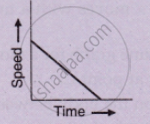Advertisements
Advertisements
Question
A car of mass 1000 kg is moving with a velocity of 10 m s−1. If the velocity-time graph for this car is a horizontal line parallel to the time axis, then the velocity of car at the end of 25 s will be :
Options
25 m s−1
40 m s−1
10 m s−1
250 m s−1
Solution
It is given that the velocity time curve is parallel to x axis hence velocity is constant with time and acceleration is 0. So, the answer is
(c) 10 m s−1
APPEARS IN
RELATED QUESTIONS
Name the two quantities, the slope of whose graph give acceleration.
What type of motion is represented by the following graph ?

Diagram shows a velocity – time graph for a car starting from rest. The graph has three sections AB, BC and CD.

From a study of this graph, state how the distance travelled in any section is determined.
From the velocity – time graph given below, calculate Distance covered in the region ABCE.

Represent the location of an object described as at 15 m, 45o west of north, on a graph paper.
Draw distance-time graph to show:
Uniform velocity
Derive the equation
S = ut+ `1/2` at2
Using a speed- time graph
State whether true or false. If false, correct the statement.
The velocity – time graph of a particle falling freely under gravity would be a straight line parallel to the x axis.
The area under the v-t graph represents a physical quantity that has the unit.
From the v-t graph, ______ can be calculated.
